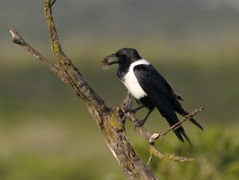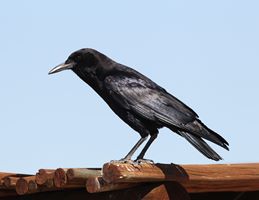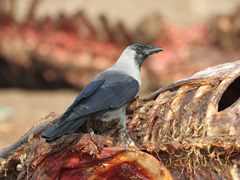A Murder of crows? Press release on crow study conducted by researchers at the FitzPatrick Institute




Photos: Peter Ryan
They steal, raid nests, and keep the company of witches. But the unpopular crow may not be as big a menace as people think. A new study has found that crows – along with their avian cousins the magpie and the raven – have surprisingly little impact on the abundance of other bird species. Collectively known as corvids, these birds are in fact being menaced by mankind in the mistaken belief that removing them is good for conservation.
The new study was led by researchers at the University of Cape Town and published this week in the leading ornithological journal Ibis1. It found that in the vast majority of cases (82 percent), corvids had no impact at all on their potential prey species. "Many nature lovers have been distressed to witness a crow or magpie raiding the nests of their beloved garden songbirds, stealing their eggs or eating their defenceless chicks," said study co-author Dr Arjun Amar2 from the Percy FitzPatrick Institute of Ornithology3. "Although this predation is entirely natural, these observations can be upsetting to witness and often leave people wondering if these predators might be reducing bird numbers."
“However, our global review suggests that we should be cautious before jumping to conclusions over the impacts these species may have. Just because a predator eats something occasionally does not always mean that they have an impact,” Dr Amar said. The study, the first of its kind, reviewed all published evidence on whether predation by corvids actually reduces the overall breeding performance of birds or, more importantly from a conservation perspective, reduces their numbers. Data were collated from 42 studies of corvid predation conducted across the globe over the last sixty years.
Not only were corvids unlikely to have any impact on their potential prey species, if there was an impact it most often affected the breeding success of the prey species rather than their subsequent numbers. Half of cases found that corvids reduced breeding success whereas less than 10% of cases found that they reduced prey numbers in the long term.
“These results have big implications for the likely benefits of corvid control,” Dr Amar said. “They suggest that killing corvids will be of most benefit to those interested in gamebird shooting rather than conservationists.” He added: “Bird hunters are usually most interested in increasing numbers of birds available to shoot immediately after the breeding season and this appears to be where corvids have most impact”. “Conservationists on the other hand, are usually interested in increasing a species population size and our results suggest that only in a very few cases did corvids have an influence on this aspect of their prey,” Dr Amar said.
The review analysed the impact of six corvid species on a variety of prey species including gamebirds, songbirds, waders, herons, cranes, sea birds, waterfowl and raptors. The 42 studies incorporated into the review included 326 cases of corvid – bird prey interaction Most of the data stemmed from field research in the UK, France and the United States. The impacts were determined partly by comparing bird counts before and after corvids were either removed or their numbers reduced.
The review also found large differences between the impacts of crows, historically considered the most 'cunning' corvid, and magpies which are sometimes killed by home owners hoping to protect songbirds in their gardens. Crow species were six times more likely to have an impact on bird prey species than Magpies. Mistaken assumptions about corvid predation were possibly explained by the birds' diurnal nature and the fact that they are conspicuous nest predators: “Their importance in prey population regulation is often assumed prior to any assessment of the evidence,” the study warned.
Chrissie Madden4, the lead author on the paper, hoped that the review would challenge the perception that all corvids were bad, thereby preventing needless killing: “Our results suggest that this is a mistaken belief and that generally speaking people would be wasting their time killing corvids to increase bird numbers”. “Overall therefore, our study points to the fact that we are often too quick to jump to the conclusion that crows and magpies may be the cause of bird population declines,” she said.
For further information and to arrange an interview, please contact:
Dr Arjun Amar – arjun.amar@uct.ac.za, Phone: +27-(0)21-6503304, Cell:+27-(0)79-5855603
Editor's notes:
1. The Ibis is a peer reviewed scientific journal published by the British Ornithologists’ Union. It has been published since 1859 and is one of the highest ranked international Ornithological journals in the world. http://www.bou.org.uk/ibis/
2. Dr Arjun Amar is a Senior Lecturer at the Percy FitzPatrick Institute and was the lead supervisor of this research project. Dr Amar has previously worked for both the Royal Society for the Protection of Birds (UK BirdLife partner), the Game and Wildlife Conservation Trust (UK NGO), and the US Fish and Wildlife Service, where he worked on a critically endangered species of crow (the Mariana Crow on the Pacific island of Rota, CNMI). http://www.fitzpatrick.uct.ac.za/docs/arjun.html
3. The Percy FitzPatrick Institute of African Ornithology is a research institute situated in the Biological Sciences Department of Cape Town University. It is one of the world’s leading ornithological research institutes and is a South African Department of Science and Technology-National Research Foundation Centre of Excellence.
4. Chrissie Madden is the lead author of the paper. The research was undertaken as part of her Conservation Biology Masters research at the University of Cape Town.
The full paper is freely available via open access.The full reference for the paper is: Madden, C.F., Arroyo, B. & Amar, A. (in press) A review of the impact of corvids on bird productivity and abundance, Ibis. doi: 10.1111/ibi.12223
Full free access: http://onlinelibrary.wiley.com/doi/10.1111/ibi.12223/abstract
